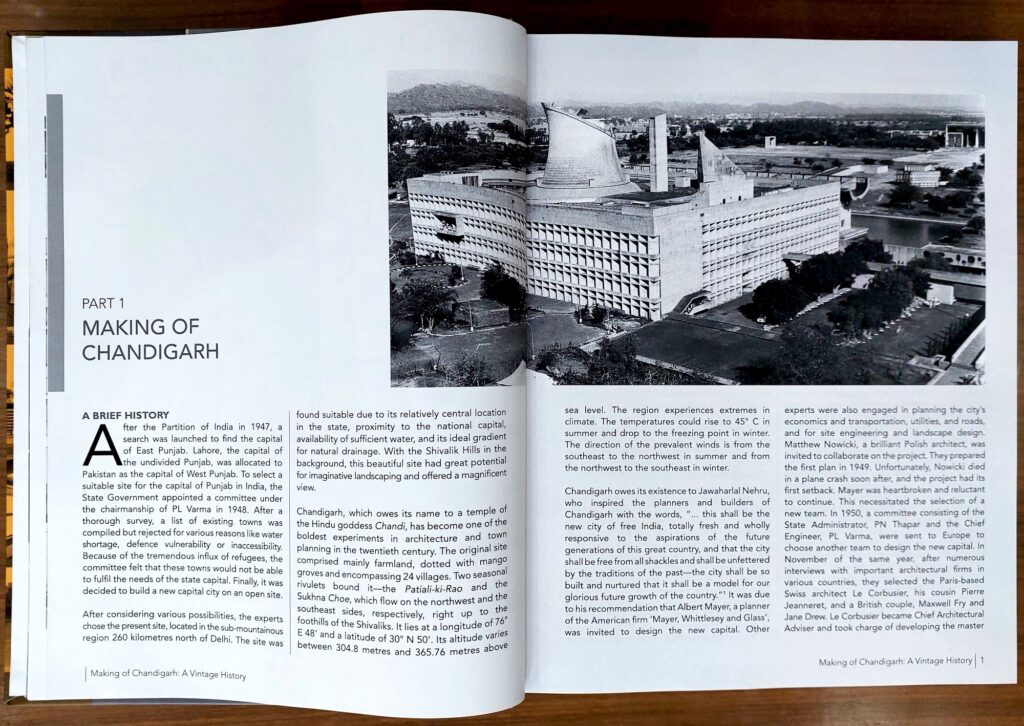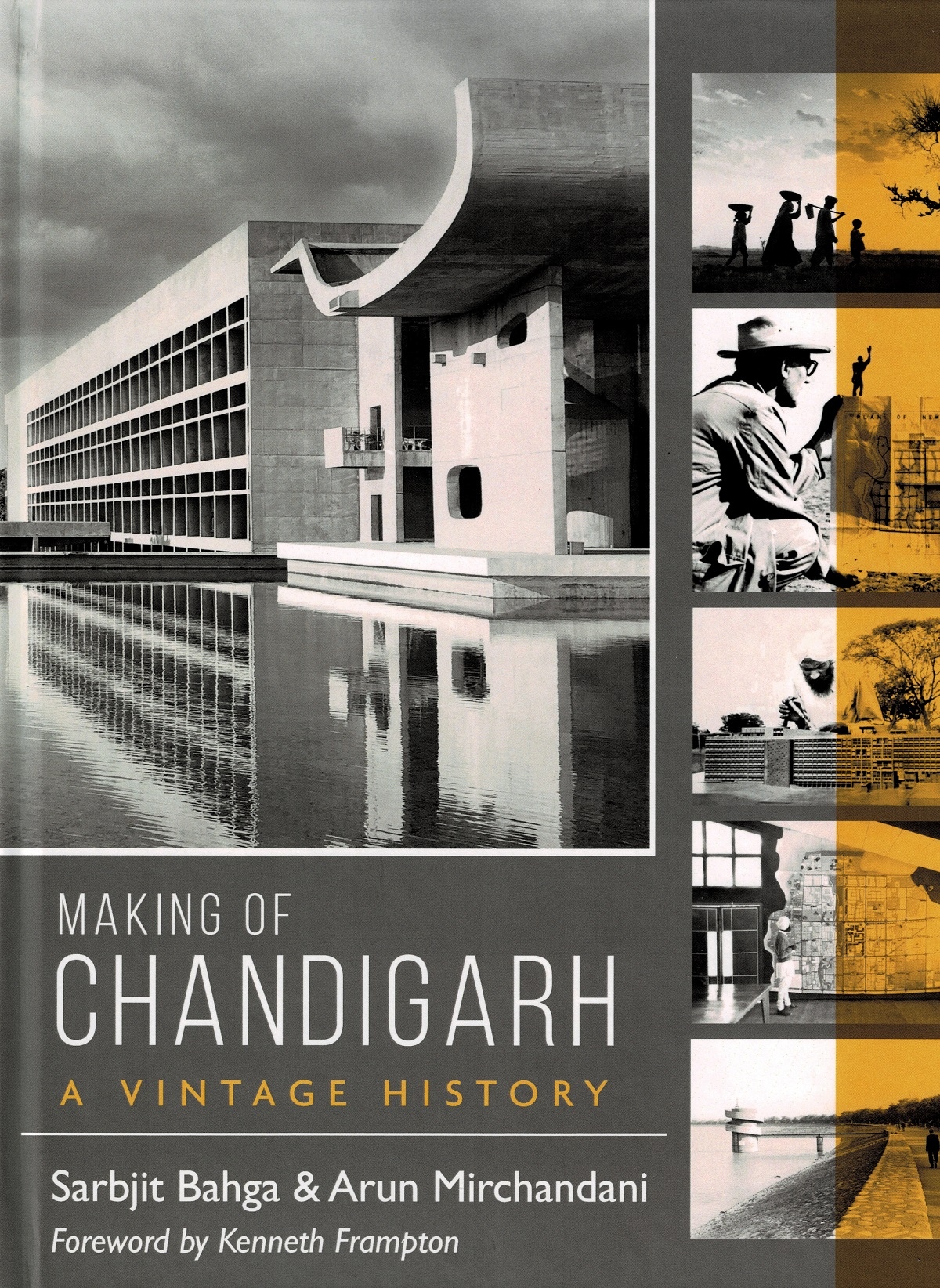
A new book titled “Making of Chandigarh: A Vintage History” co-authored by Sarbjit Bahga, a Chandigarh-based architect, and Arun Mirchandani, a Delhi-based archivist, has recently been released. The Foreword to the book “Chandigarh: An Overview” has been written by Kenneth Frampton, a British architect, critic, and renowned historian of modernist architecture. White Falcon Publishing published the lavishly designed, 410-page, black/white book available worldwide through online portals.

Chandigarh is a giant experiment in town planning and architecture in India and the world. “Among the relatively few bespoke cities designed and built in the 20th century, ranging from Chandigarh to Brasilia (1956) and Curitiba (1965), both being in Brazil ending with the diminutive Milton Keynes in 1972, Chandigarh stands out as the only city to achieve a subtle synthesis between urban and suburban land settlement patterns,” wrote Kenneth Frampton in the Foreword.
Being one of the best cities planned and built afresh on virgin land, Chandigarh attracted the global community of architects, planners, and historians. As a result, copious works have been written on Chandigarh, and much literature exists on the subject.


“Making of Chandigarh: A Vintage History” is the latest addition to the several books written by various authors on this subject. Of all the treatises published earlier, this book is unique in its approach, contents, and presentation.
The book focuses on recording the city-making process through 575 black-and-white photographs. Several photographers have clicked these photographs since the city’s inception in 1950 till the 1990s. This book is a tribute to the numerous known and unknown photographers who recorded the history of Chandigarh through their photographs.


It is said that a picture is worth a thousand words, and photographers are worth a million. Imagine, if we glance through hundreds of pictures clicked on a particular subject over 40 years beginning in 1950, how easy it will be to grasp the historical aspect of that subject! With this aim, the “Making of Chandigarh: A Vintage History” has been conceived and presented as a pictorial journey of the city.
Apart from the rich collection of vintage photos, the book includes more than 50 drawings of important city buildings and campuses. An elaborated essay, ‘Making of Chandigarh,’ explains the whole story of the capital city and throws light on the essential campuses, complexes, and buildings designed by master architects like Le Corbusier, Pierre Jeanneret, Maxwell Fry, Jane Drew, and their Indian colleagues.


The entire material, i.e., text, drawings, and photographs, has been arranged in two sections – 1. Making of Chandigarh, and 2. Chandigarh in Pictures. The first section – Making of Chandigarh, explains a brief history of Chandigarh and dwells on the Capitol Complex, Residential Buildings, Commercial Complexes, Educational Buildings, Cultural Complexes, and Recreational Places. The second section, Chandigarh in Pictures, features 575 vintage photographs of Chandigarh clicked from 1950 to 1990. These pictures have been arranged in sub-sections like Site of Chandigarh, Temporary Site Office, The Creators of Chandigarh, Capitol Complex, Residential Buildings, Commercial Complexes, Educational Buildings, Cultural Complexes, and Recreational Places. All the photographs are well captioned for easy and quick understanding by readers.
The authors, Sarbjit Bahga and Arun Mirchandani elaborate that “Making of Chandigarh: A Vintage History was conceivedand presented as a coffee-table book for the use of five sections of the society to give them an overview of the planning, designing, and development of the capital city. The first group we hope to reach comprises professionals like architects, planners, engineers, builders, and other people engaged in building activity. The book should act as a source of inspiration to stimulate their creative instincts. In the second group, we aimed to reach historians, authors, researchers, and architectural archivists. The book is expected to provide sufficient material for thought-provoking and pursuing further research on this or similar other subjects. The third group we have in mind is students of art, architecture, town planning, urban design, landscape design, and photography. Hopefully, this book will help broaden their horizons and teach them a new way of thinking. The fourth section of readership includes Indian and foreign tourists on sightseeing and architectural tours. The fifth section we are trying to reach is the general reader with sufficient interest in modern architecture and planning. We hope that this book will meet readers’ expectations. If so, we shall be glad to have achieved our objectives as enunciated above.”


As a tribute, the book is dedicated to all the known and unknown photographers who clicked photographs of Chandigarh from the 1950s to the 1990s. Besides, as an ode, it is also dedicated to all the unknown workers, masons, laborers, plumbers, electricians, drivers, and helpers who were instrumental in realizing the city of Chandigarh.
A marathon pictorial journey of Chandigarh through this book concludes with Herb Caen’s quote, “A city is not gauged by its length and width but by the broadness of its vision and the height of its dreams.”
Book details:
- Title: Making of Chandigarh: A Vintage History
- ASIN: B0CKTCJLY5
- Publisher: White Falcon Publishing (10 October 2023)
- Hardcover: 410 pages
- ISBN-13: 979-8892220118
- Item Weight: 2 kg 300 g
- Dimensions: 21.59 x 2.54 x 27.94 cm
- Country of Origin: India









One Response
Thank you so much ji for publishing book review of our book so nicely. We are humbled. Regards.